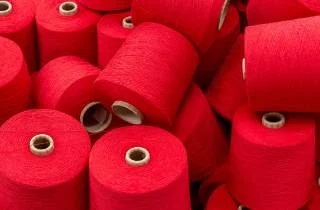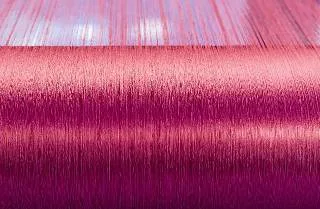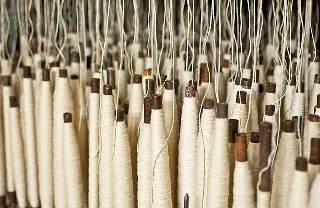Fabric manufacturing
Fabric
manufacturing is a major industry based primarily on the conversion of fiber
into yarn, then yarn into fabric. These are then dyed or printed and made into
fabrics which are then converted into useful products such as clothing,
household items, furnishings or upholstery, and various industrial products. All
in all, a lot can be made with cotton, not just clothes. Cotton is the most
widely used and common natural fiber, making up 90% of all-natural fibers used
in the textile industry. People often use cotton clothing and accessories for
comfort, not limited to different weather conditions. Many variable processes
are available at the spinning and fabric-forming stages and are combined with
the complexity of finishing and dyeing processes for the production of a wide
range of products.
Fiber into yarn manufacturing process
Cultivation & harvesting
Cotton
grows anywhere with long, hot dry summers with plenty of suns and low humidity.
Planting is done from September to mid-November and harvested from March to
June. Cotton bolls are cut by stripper harvesters and spindle pickers that
remove the entire boll from the tree. The cotton boll is the seed pod of the
cotton plant; each of the thousands of seeds contains about 2.5 cm long fiber.
Ginning
It
also contains cotton seeds when collecting cotton from cotton plants. So cotton
seeds need to be removed during cotton processing. The process of removing
cotton seeds from this cotton is called ginning. In a saw gin, the circular saw
grabs the fiber and pulls it through a grate that is too narrow for the seeds
to pass through. A roller gin is used with the long-staple cotton. Here, a
leather roller captures the cotton.
Bale opening
Cotton
is shipped to mills in large 500-pound bales. When the cotton comes out of a
bale, it is all packed together and still contains the vegetable substance. The
bale is opened using a machine with a large spike, called an opener. To fluff
cotton and remove vegetable matter, cotton is sent through a picker or similar
machine. In a picker, the cotton is beaten with a beater to loosen it. It is
then fed through various rollers, which remove the vegetable matter.
Scutching
Scutching
is a step in processing cotton for spinning. The scotching process separates impurities
from raw materials, such as straw from raw cotton seeds or flax fibers and wood
stems. Scotching can be done by hand or by a machine known as a scotch. Hand
scotching of flax is done with a wooden scotching knife and a small iron
scraper.
Carding
Carding is a mechanical process that separates, cleans, and blends fibers to create a seamless web or sliver suitable for subsequent processing. This is achieved by crossing the fibers between differently moving surfaces covered by card fabric. It breaks the unorganized clamps of locks and fibers and then aligns the individual fibers to be parallel to each other. In the case of preparing wool fibers for spinning, carding is the next step after teasing.
Combing
Combing
is a method of preparing combed fiber for spinning. It is divided into linear
and circular combs. The Nobel comb is an example of a circular comb. Example of
French comb linear combing. The combing process is accompanied by gilling, a
process that makes the evening out carded or combed top suitable for spinning.
The comb separates the smaller fibers by a rotating ring or a rectilinear row
of steel pins. The 'top' fibers it produces are straightened and parallel to
each other. When wool is combed, the small fibers thrown away are called noils
and they are turned into shoddy.
Draw-frame
Carded
slivers are fed into a draw-frame and stretched/straightened to form a single
sliver. Also, fiber blending can be done at this stage. The cans containing the
sliver are placed with the draw-frame feeder rack, usually, with eight pairs of
cylinders, the bottom cylinder is positively pointed, while the top rests on
the bottom to ensure the movement of the relative sliver.
Doubling
Doubling
is a process used to make yarn through which a product is produced from
multiple intermediate feed products. For example, sliver doubling where 4 to 8
slivers are fed to draw the frame and 1 sliver is delivered. On the other hand,
drawing the draft reduces the linear density of a fibrous assembly. This
process is called drafting and the drafting operation increases the inequality.
The function of the draw frame is to double and provide drawing at the same
time.
Roving frame
This is an intermediate process where the fibers are transformed into a low twist lee called roving. The sliver taken from the draw frame is thick so it is not suitable for making yarn. The purpose is to prepare an input package for the next process. This package is prepared on a small compact package called a bobbin. The roving machine is complex, liable to a fault, causing errors, adding production costs, and delivering products. This winding operation complicates our roving frame. It shrinks into a fine thread, gives more twists, makes it more regular and even thicker, and blows air over a smaller tube.
Ring frame
A ring frame is a method of spinning fibers like cotton, flax, or wool to make yarn. The ring frame evolved from the throstle frame, which in turn was a descendant of the Arkwright's water frame. The eroded roving spindle moves to the assembly, where it is threaded through a small ring called the Traveler. The traveler moves along the ring. This is the name given to this ring frame. From here the thread is attached to the existing thread on the spindle. The traveler and the spindle share the same axis but rotate at different speeds. The spindle is driven and the traveler is pulled back, thus distributing the rotation between the spindle and the twist in the yarn.
Doffing
Doffing
is a separate process. An attendant blows air down the ring rail. The machine
stops. The thread guide is hinged up. The entire bobbin coil (yarn package) is
removed from the spindle. The new bobbin tube is placed on the spindle, holding
the thread between the thread and the cup in the spindle's wharf, the thread
guides are lowered, and the machine is restarted. Now all the process is done
automatically.
Yarn into fabric manufacturing process
Winding
The
formation of large yarn packages that can be smoothly unwound is known as
winding during the subsequent process. It is the most necessary process in both
yarn manufacturing and fabric manufacturing. The main purpose of winding is to
create a suitable package for both woven and knitted fabrics. The most common
packages are cone and cheese packages. Both packages are cross-wound packages.
Warping
Warping is the process of making a sheet by assembling yarn from different cones. The important thing in warping is to preserve the yarn spread and keep it at a uniform level. This is done to achieve better performance during weaving in terms of low-end breakage rate. The slab catcher and tensioner setting are very important in warping machines. A uniform warping speed is also very important. Ideal control of yarn tension can be achieved by combining the tensioner setting with the warping speed. The tensioner should be given low tension at high warping speed and high tension at low warping speed. Providing yarn by air drag will provide tension balance as it ensures high tension at high speeds and low at low speeds.
Sizing
Textile
warp yarn sizing is essential to reduce yarn breakage and thus stop production
on the weaving machine. In weaving machines, warp yarns undergo a variety of
activities such as cyclic strain, flexing, friction between different parts of
the loom, and inter-thread friction. With sizing, yarn strength and abrasion
resistance will improve and the hairiness of yarn will decrease. The level of
strength improvement depends on the strength of the fiber and the adhesion
strength between the size, size penetration, as well as yarn encapsulation. The
type of yarn material (such as cotton, polyester, linen), the thickness of the
yarn, and the type of weaving machine will determine the sizing recipe.
Drawing-in
The
drawing-in process, in the order indicated by the draft, separates each end of
the warp through reed dents and healds eyes. The drawing-in process comes right
after the weaver beam is made. Weaver beams are obtained from sectional warping
or sizing. The drawing process consists mainly of two processes. The first
process is called drafting and the second process is called denting. This is
mostly done manually but in large-scale textile industries, automatic
drawing-in process machines are used, where more productivity is required.
Pirning
Pirn or weft winding is the process of transferring a weft yarn to a small Pirn that can be used in a loom shuttle. A tapered bobbin has a weft thread called a Pirn. A Pirn is used in the end feed shuttles. The Pirn is different from the bobbins in that the Pirn are tapered.
Weaving
Weaving
is a method of textile production where two distinct sets of yarn or threads
are joined at right angles to form a fabric. Other methods are knitting,
crocheting, felting, and braiding or plating. Longitudinal threads are called
the warp and lateral threads are called weft, or filling. The method in which
these threads are interwoven affects the properties of the fabric. Fabrics are
usually woven into looms, a device that holds the warp threads in place while
the threads are woven through them while they are being filled.


















0 Comments